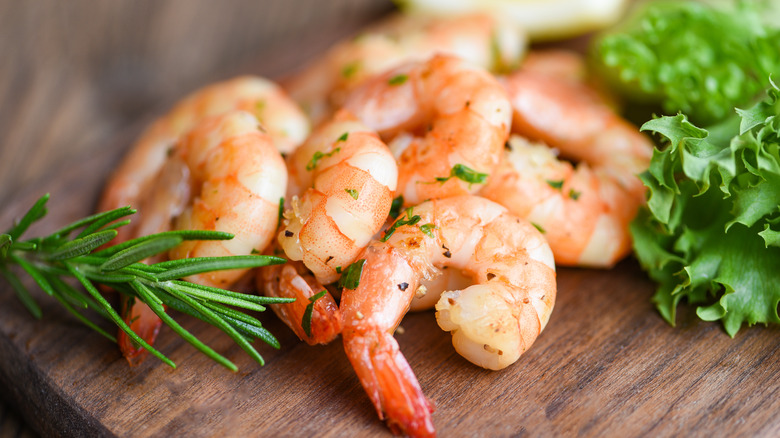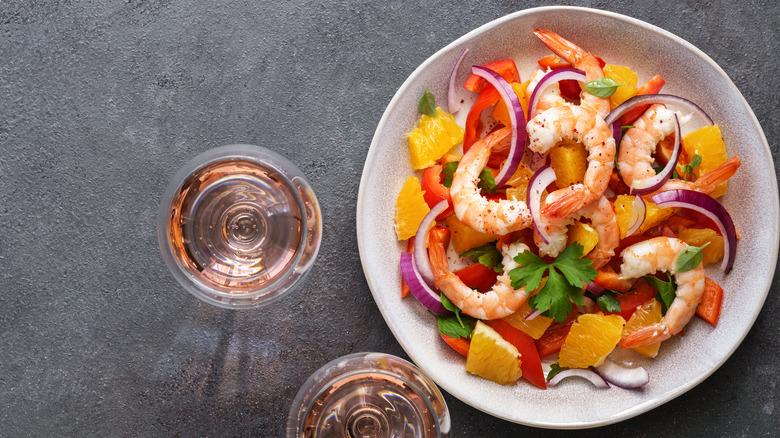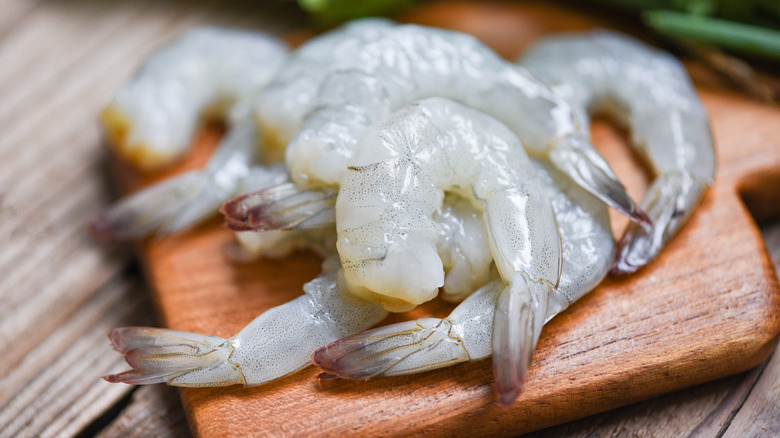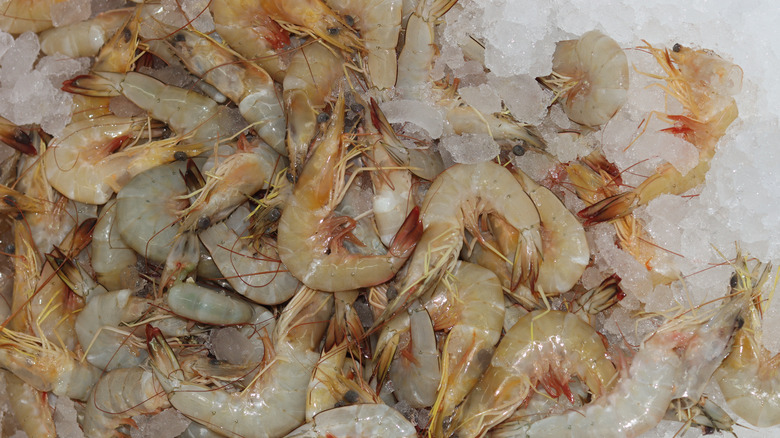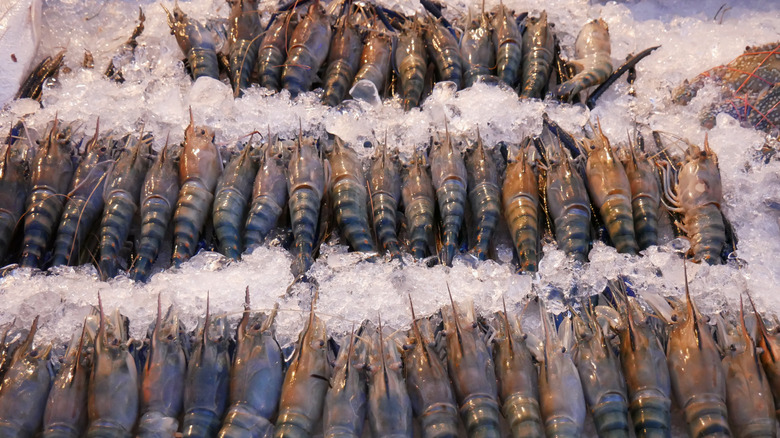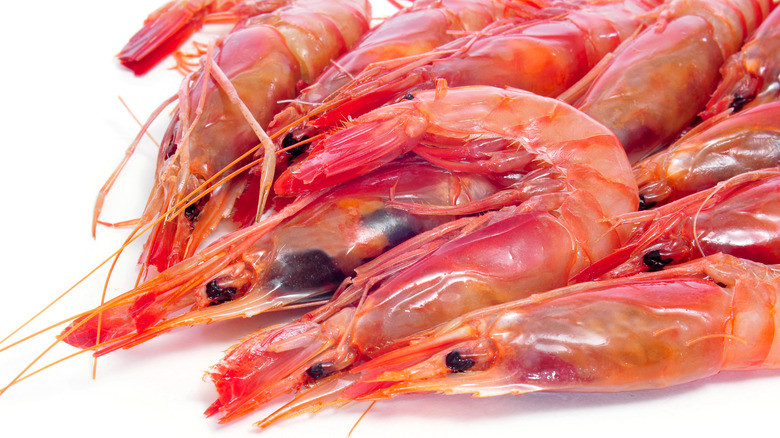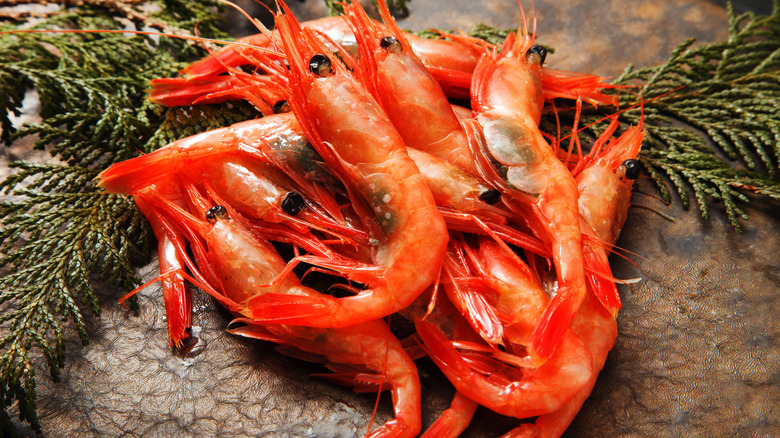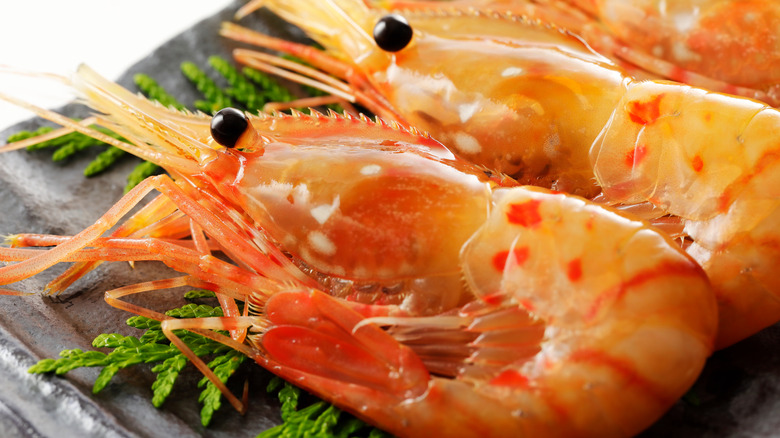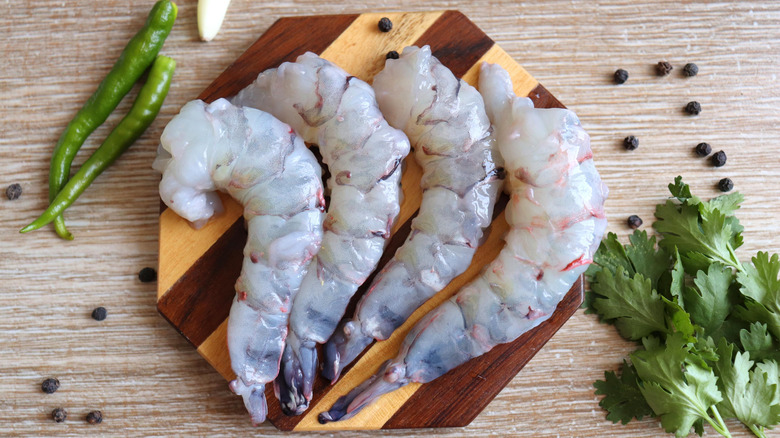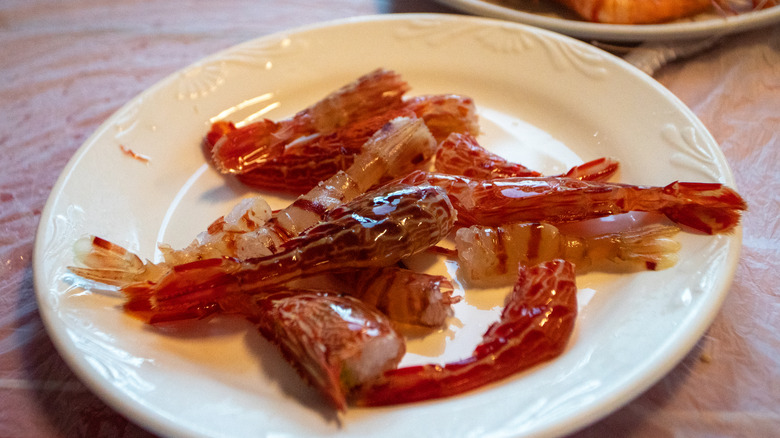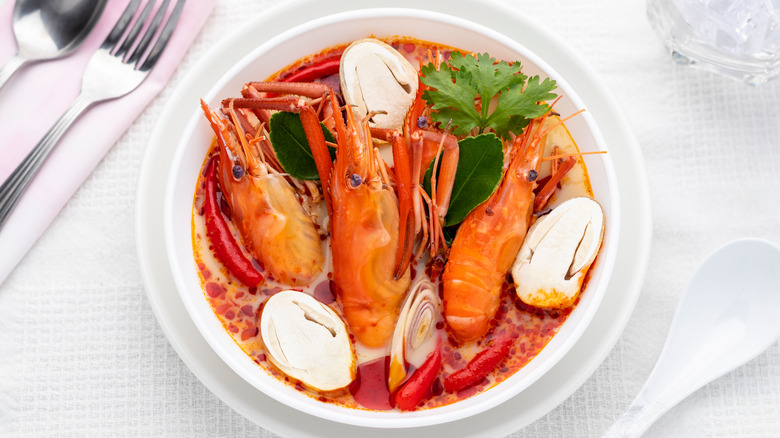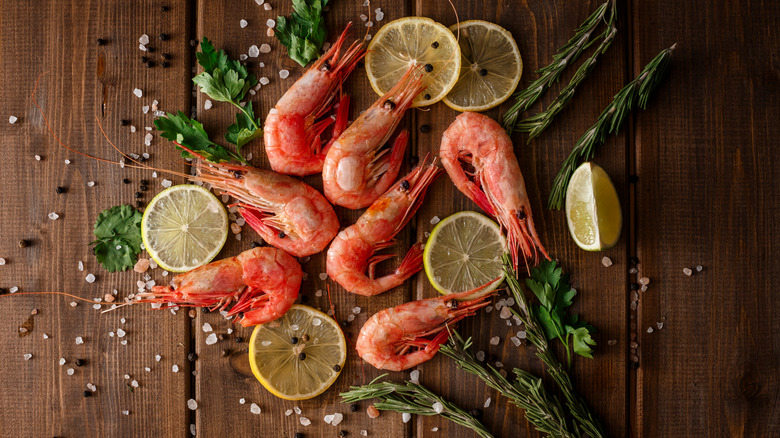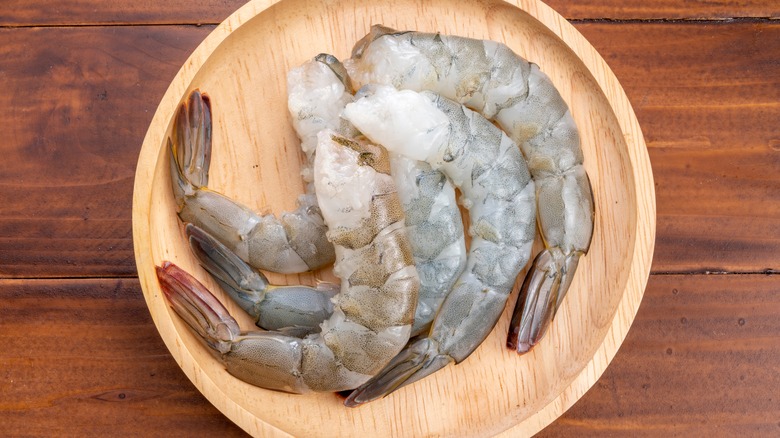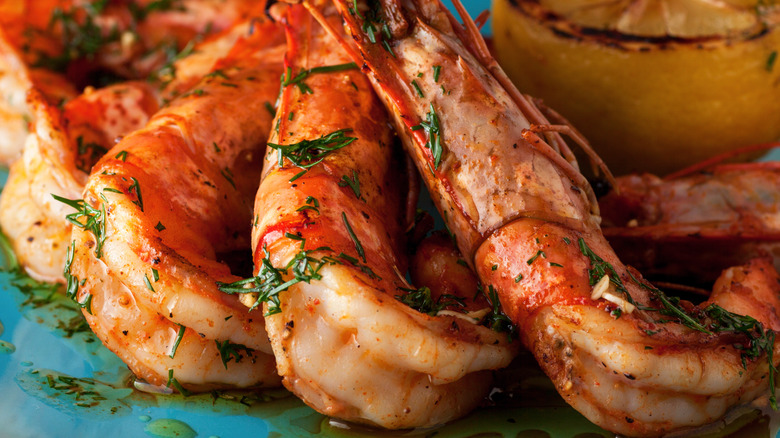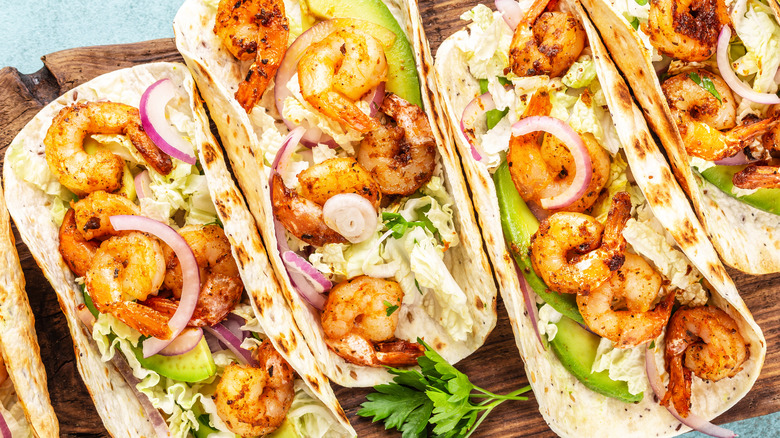14 Types Of Shrimp You Should Get To Know
Shrimp is the most popular seafood consumed in the U.S., handily beating the fins off of its closest competitors, salmon and tuna. Aside from being a good way to get protein, omega-3 fatty acids, and important nutrients like iodine, shrimp is light in calories and carbs, making it suitable for many diets. That these juicy, succulent little crustaceans are healthy is just a bonus on top of their culinary versatility and all-around tastiness. It's no wonder they're so wildly popular.
There are thousands of varieties of shrimp and prawns gracing our waters, in all different sizes and colors. While the terms shrimp and prawn are commonly used interchangeably, technically they are two distinct creatures with subtle physical differences; though as far as cooking and eating go, they taste and can be prepared in the same ways. So there's no need to get worked up over terminology.
A few key tips can help you when shopping for shrimp. Shrimp's quality degenerates quickly after being caught, so frozen shrimp are usually your best bet, unless you're buying straight from a fishing boat. When shopping for shrimp and prawns, look for IQF, or individually quick-frozen, shrimp that have no additives. Opt for wild over farmed shrimp for more flavor, and shell-on for best quality. Different varieties of shrimp lend themselves well to various preparations — here are some of the best types of shrimp to get to know so you can show off your shellfish prowess.
Pink shrimp
Pink shrimp is a category that encompasses many different popular shrimp species that are found in both the Atlantic and Pacific Oceans. They're generally plump and sweet with a supple texture, and can vary in size from quite small to up to 11 inches in length. Their variety and versatility make pink shrimp a solid option for all kinds of recipes and cuisines.
Gulf pink shrimp are caught in warm waters, primarily around the coast of Florida. Their mild taste makes them an excellent all-around shrimp for classic preparations like risotto or garlicky, buttery scampi. But they're also at home in dishes that showcase their meaty, juicy texture, like when they're breaded and fried in this spicy shrimp po'boy.
Oregon pink shrimp are another popular variety that can be found along the West Coast from California to Alaska. They tend to be on the small side, making these little beauties ideal for salads like this simple and fresh avocado shrimp salad.
White shrimp
Species of white shrimp are found around the world, including the Gulf of Mexico, the coasts of China and Korea, and the Pacific waters off Central and South America. From habitat to habitat, these white shrimp have subtle differences, but generally they exhibit a clean, fresh shrimp flavor that's fairly mild and sweet and have a firm yet tender texture. They vary in size, topping out at around 9 inches, with the Gulf and Pacific varieties generally larger than Chinese white shrimp.
White shrimp can be prepared in similar ways to pink shrimp, as they're both mild with springy yet firm flesh that can hold up to many types of cooking, from boiling to steaming to grilling, making them a versatile option in the kitchen. Thanks to the pure, clean saltwater taste of white shrimp, they're particularly well-suited to dishes that showcase their natural flavor and toothsome texture, like this shrimp cocktail salad or a simple stir-fry.
Brown shrimp
Brown shrimp are a very common species found along the eastern American coast and in the Gulf of Mexico. They're named for the grayish-brown tinge of their shells. Like both pink and white species of shrimp, brown shrimp can vary in size, getting up to about 7 inches in length, making them fairly small. More than other species, brown shrimp tend to have a strong iodine flavor, which comes from their diet rich in organisms that contain bromophenols. This comes across as an intense briny taste.
Keep this characteristic in mind when deciding what recipes to make with brown shrimp. Thanks to their bold, sea-salty character, these shrimp stand up well to stronger flavors, making them a perfect variety to use in Cajun and Creole cooking. Try them in dishes like shrimp and chicken jambalaya and shrimp etouffee. They also make a great addition to paella, adding their unique oceanic flavor to the classic Spanish dish. And if you want to get the most out of your brown shrimp, their shells make a particularly potent and flavorful shellfish stock.
Brown rock shrimp
They may easily be mistaken for lobsters or crawfish at first glance, but brown rock shrimp are one of the more unique members of the shrimp family. These heavily armored crustaceans live in deep ocean waters, primarily along the eastern U.S. and Mexican coasts. Just like lobsters, their shells are tough to crack, but the meat inside is rich and delectable with a delicate sweetness. They're often sold as meat already removed from the shell, since it can be difficult to break through.
If you find these shrimp whole, the rock-hard shell can actually work as an advantage for certain preparations, like grilling over an open flame. The sturdy carapace protects the meat inside, letting it cook through gently without getting charred. The meat can be used in much the same way you'd use crab or lobster, in recipes that will enhance its richness and delicacy without overwhelming it. Rock shrimp are great in pasta preparations like this simple summery pasta with rock shrimp, tomatoes, and corn. They also make a great shellfish alternative in lobster mac and cheese.
Atlantic northern shrimp
Atlantic northern shrimp are small, delectably sweet, and tender crustaceans that lend themselves well to multiple cooking techniques and preparations. Unfortunately, they've become victims of rising ocean temperatures, and their habitats along the coast of New England, primarily Maine, have become too warm for them to call home. Since 2014, there's been a moratorium on fishing for these shrimp in the United States, although they can still be caught in Canadian waters where they are not yet subject to overfishing and the temperatures are still cool enough for them to successfully reproduce.
These beautifully bright pink, juicy, and flavorful little shrimp are incredibly sweet and delicious, which makes their struggle to survive a real shame. With careful monitoring of their populations and a determination to help them thrive in habitats that can support them, there is hope that Atlantic northern shrimp can increase their numbers everywhere so that someday they can once again thrive. If you can find Canadian Atlantic northern shrimp, enjoy these flavor-packed shellfish in creamy pasta recipes like shrimp linguine alfredo.
Royal red shrimp
Royal red shrimp are aptly named. Along with their vibrant red shells, their flavor is nothing short of majestic, exhibiting the tender meatiness of sea scallops along with the delicate richness of lobster. They're found in deep waters in several parts of the world, including South America and Australia, but arguably the best come from the Gulf of Mexico. These silky, supple, and naturally salty shrimp are as delicious as they are visually stunning.
These delicacies don't need much to optimize their flavor. Like crab, scallop, and lobster, the exquisite richness of royal red shrimp should be enhanced and accentuated in a subtle way. They cook quickly, so a careful hand is needed when preparing these shellfish. Their tender, creamy texture works beautifully with butter and gentle seasoning. Too much spice and intensity can overwhelm the nuance of these fine shellfish, so it's best to keep them the star of the show by keeping things simple and elegant.
Spot prawns
The spot prawn is technically a shrimp, though it's more commonly known by the term prawn. These crustaceans inhabit the Pacific depths from southern California to Alaska, and east to the Sea of Japan. They're large in size, the largest variety of shrimp found in these waters, reaching lengths of over 10 inches. Despite their imposing size, their meat is delicate, tender, and appealingly sweet. Like other shrimp that exhibit these lobster-like characteristics, spot prawns don't need bold spices or other strong flavors — they're best when left largely alone so that their inherent qualities are enhanced rather than smothered with too much intensity.
Simply steamed, boiled, or sauteed in butter is all it takes to bring out spot prawns' ideal flavor and texture. Fresh herbs like dill or parsley can add dimension while still keeping the shrimp's flavors center stage. The size of these shrimp make them prime ingredients for showstopping dinner party dishes, thanks to their impressive visual appeal.
Tiger shrimp
Tiger shrimp, also known as black tiger shrimp and black tiger prawns, are a major player in the seafood markets of many Asian countries. Most come from farms, although some are caught in the wild, and are much more flavorful than their cultivated counterparts. Their striped shells and flesh are what give these crustaceans their name and make them easy to identify compared to other shrimp. Tiger shrimp can grow to an impressive 13 inches in length, and these larger ones are often labeled as giant tiger shrimp.
These shrimp are mild in flavor and soft in texture. Their considerable size and unique appearance make them dramatic additions to many dishes — they're great served as a jumbo shrimp cocktail, simply skewered and grilled, or served as part of a surf and turf combo, like grilled rib eye and prawns. Or try these mild crustaceans in dishes with lots of flavor intensity, like in this recipe for Malaysian chili sesame prawns.
Coonstriped shrimp
The coonstriped shrimp is primarily found in the cold waters of the northern Pacific Ocean, from Washington and Alaska to Korea and Japan. Alternatively called coonstripe or coonstriped, or simply "coonies" or dock shrimp, these crustaceans have a similar appearance to spot prawns but are smaller in size, averaging just 4 to 6 inches long. Their small size can make their shells tough to peel, but the sweet, buttery meat inside is worth the effort.
Simple flavors bring out the juicy sweetness of these shrimp. A quick toss in a pan with butter or olive oil and garlic is really all you need, perhaps served over pasta or with a side of crusty bread. They only take a few minutes to cook through completely. Coonstriped shrimp shells are flavorful and make an excellent base for seafood stock, as well as in soups like creamy shrimp bisque or hearty shrimp and chickpea soup.
Giant freshwater prawns
Sometimes known as the giant river prawn or freshwater shrimp, the giant freshwater prawn is the largest freshwater shrimp. It lives wild in the inland waters stretching from Pakistan and India to southeast Asia, as well as parts of Australia. As its name suggests, this variety of prawn grows to massive size, capable of reaching over a foot in length, particularly in the wild. It's largely farmed in areas throughout the world where it's not native, such as Hawaii and other parts of the United States, in which case it's typically kept to about half that size. It's also known as the Hawaiian blue prawn thanks to its blue-tinted shell and long blue legs, although, like most shrimp and other shellfish, it turns pink and red when it's cooked.
The giant freshwater prawn's flavor and texture are similar to that of lobster, a shellfish they also somewhat resemble, although the prawns have long, more slender claws in comparison, with the tails being where the meat is. These hefty prawns benefit from being cooked in their shells, like lobsters, to keep the flesh firm, juicy, and flavorful. They take well to roasting, boiling, and grilling whole, and aren't afraid of strong and spicy flavors.
Sidestripe shrimp
Sidestriped shrimp are found in the northern Pacific waters along the coasts of Alaska, Canada, and Washington. They're somewhat similar in appearance, flavor, and texture to coonstriped shrimp or spot prawns but are between both of those in size, as they can grow to be up to 8 inches long. Their name comes from a subtle pattern of red and white stripes along the shrimp's body.
Like their two neighboring varieties, sidestriped shrimp are best when prepared simply and elegantly, letting the natural clean sweetness and buttery rich texture shine without being taken over by too much intensity from other ingredients. Slender yet meaty, these shrimp have a great texture for salads and add a clean, fresh flavor that goes well with green herbs and bright ingredients like citrus and vinegar. That makes them the perfect variety to use in dishes such as shrimp ceviche, escabeche, and of course, shrimp cocktail.
Banana prawns
Banana prawns are found in the western Pacific Ocean, most commonly around Australia, where they are extremely popular to eat. There are actually two different species of banana prawns, differentiated by the color of their legs, but as far as flavor and culinary usage go, the two varieties are interchangeable. These prawns can grow to be quite large, almost 10 inches, although if they're farmed they can be much smaller than their wild counterparts.
The flesh of banana prawns is mild, sweet, and meaty and takes to many different cooking preparations. They're perfectly suited for the grill, as their size and natural moistness allow them to cook well over an open flame without getting tough or dried out. The sturdy meat holds its shape well and can stand up to big flavors, so don't be shy pairing your grilled shrimp with a bold side, like this cilantro-chili dipping sauce. Or break out your spices and use them to make these flavorful masala prawns.
Red Argentine shrimp
Argentinian red shrimp live along Argentina's coastline and are commonly found way down south around Patagonia. These shrimp have become highly coveted by consumers in recent years, as their incredibly sweet flavor and supple texture are luxuriously reminiscent of lobster, as is their vibrant red color. Their popularity has brought many challenges, however: Bottom trawling is often used to catch them, which negatively affects the delicate underwater ecosystem. There have been promising advances in sustainable harvesting for these crustaceans, but Seafood Watch still has them on its list of items to avoid.
If you can find a reputable vendor and ensure that your shrimp are sustainably caught, Argentinian red shrimp are well worth the effort. Their exceptional taste, substantial size, and buttery texture can be used in place of other types of shrimp to upgrade recipes from pasta to stir-fries. These shrimp shine in place of lobster in a classic New England-style lobster roll — you may not be able to tell the difference.
Mexican blue shrimp
Mexican blue shrimp are another variety of seafood that have seen more eco-friendly harvesting improvements in recent years. Wild-caught along the coasts of Sonora and Sinaloa in the Gulf of California, these shrimp have a distinct blue-gray tinge to their shells. When cooked, the meat is succulent and fresh tasting with a satisfying snap and subtle saltiness that balances out the shrimp's naturally sweet flavor. These shrimp are highly sought-after, and thanks to that demand, it's important to seek out shrimp that are Fair Trade Certified and sustainably caught, which should be clearly stated on the product's label.
Their variety of sizes makes these shrimp versatile when it comes to cooking. They take well to any technique, from grilling to frying to roasting. Smaller Mexican blue shrimp are the perfect choice to fill a Baja shrimp taco or shrimp burrito, with their satisfyingly meaty, springy texture. Larger shrimp work well in bold dishes like camarones a la diabla, as they can take on spices like chile de arbol and cayenne pepper. Island flavors like tropical fruits, Jamaican jerk seasoning, and zesty citrus complement Mexican blue shrimp extremely well.
